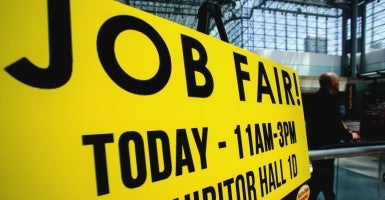American employers created 151,000 net jobs in January, reflecting an economy that is growing, but below its previous trends. The Bureau of Labor Statistics also reported that participation in the labor force was 62.7 percent, higher than the previous months but lower than the January, 2015, level. The best news was that average hourly wages rose 12 cents over the previous month to an all-time high of $25.39.
Unemployment ticked down to 4.9 percent, the first time since February, 2008, that it has been below 5 percent. Regrettably, the average duration of unemployment rose to 28.9 weeks, far above pre-recession levels.
Other economic indicators suggest both that the U.S. economy has failed to return to the pre-Great Recession trends and that liftoff is not about to take place.
After a disappointing fourth quarter, gross domestic product finished 2015 just 1.8 percent higher than its 2014 close.
According to the Congressional Budget Office, total U.S. output is still 2.4 percent below potential, essentially unchanged from the previous year. And the “output gap” would be significantly larger relative to CBO’s earlier projections of potential output. As the mediocre recovery has continued, expectations have eroded.
Manufacturing output in the U.S. (measured by the value of durable goods shipments) stalled out in mid-2014 despite low energy prices. The share of the labor force working part-time for economic reasons has been declining but is still well above pre-recession levels.
One of the bright spots in the recovery was the number of job openings, which grew rapidly until July, 2015, but has receded slightly since then. The quit rate—which indicates how confident workers are about their chances of finding new employment—is slightly below its pre-recession level.
Some economists are calling this new normal “secular stagnation.” However, that does not fit the facts. In secular stagnation, the economy would be in a near-zero growth environment, with troubling implications for investment. In the current environment, the economy is growing, but at a lower level than anticipated. This can be explained by the introduction of major new regulations on bank lending—Dodd-Frank—and a deepening moat of regulations, Obamacare first among them, that protect incumbent firms and allow them to earn monopoly profits.
Since the early 20th century, the United States has been at the cutting edge of economic growth, enjoying new inventions and implementing better business practices a few years before other countries. But that place is not guaranteed. As U.S. economic freedom slips behind countries like Switzerland, Canada, and Singapore, those countries may move into pole position, making the most of new technology and allowing workers to maximize their income.
To make America great once more, Congress, the administration, and even state and local governments need to repeal costly regulations that make it harder to borrow, harder to invest, harder to switch jobs, and harder to get a good education.





























